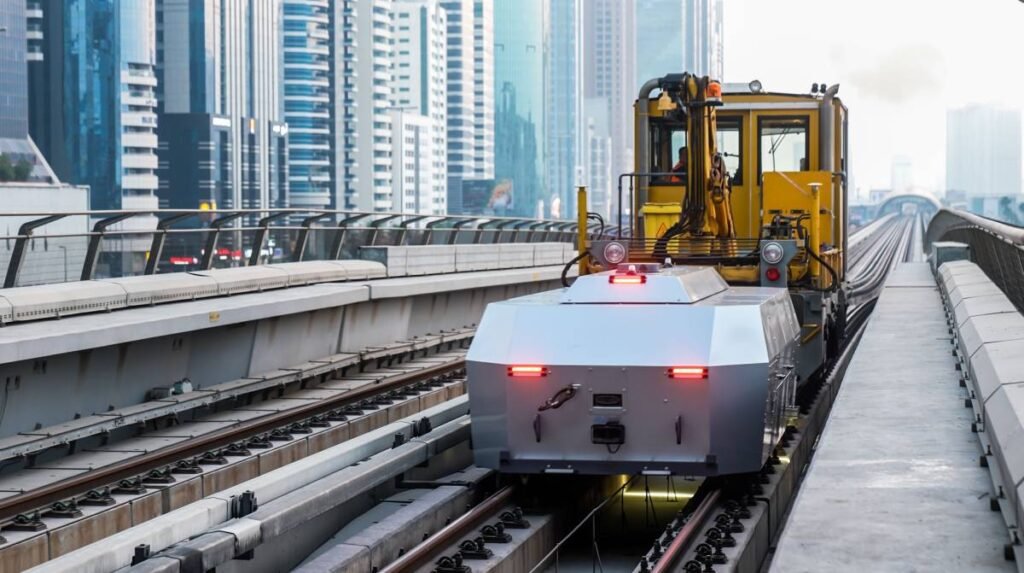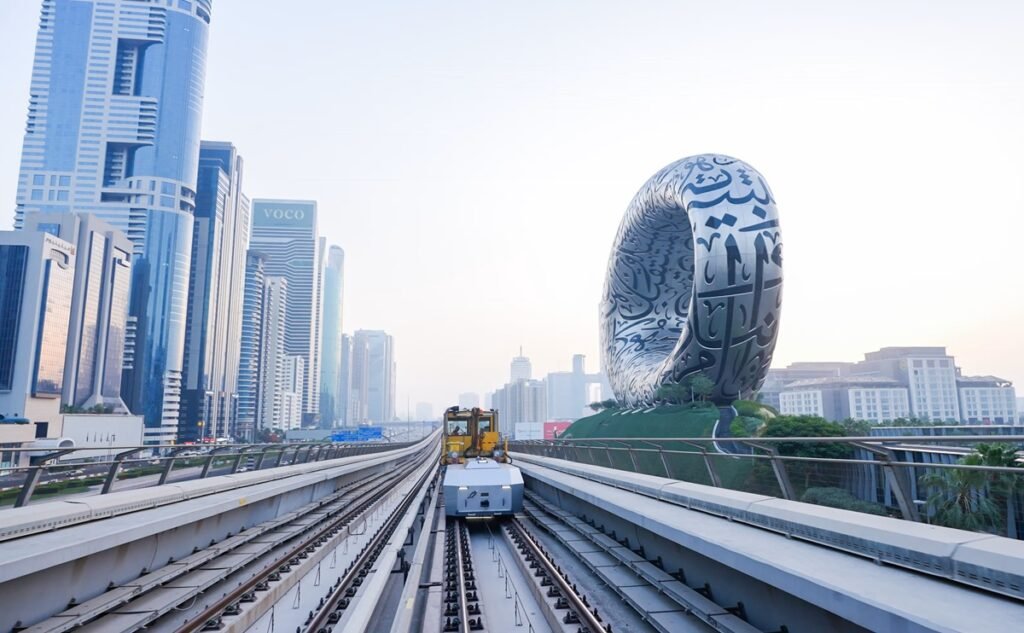Dubai has done it again. In a bold move blending cutting-edge technology with urban infrastructure, the Dubai Metro has officially deployed an AI-powered inspection robot that slashes inspection time by an astonishing 75%. The initiative, spearheaded by the Roads and Transport Authority (RTA), is a milestone in the city’s ongoing mission to create one of the smartest and safest transit systems in the world.
This smart robot isn’t just a gimmick. It’s a game-changer that promises quicker inspections, earlier fault detection, and safer commutes for millions of passengers every year.
Why Dubai’s AI Robot Is a Big Deal
Before the arrival of this AI marvel, track inspections required thousands of man-hours, often taking weeks to complete. These manual checks were prone to fatigue, human error, and delays, especially under harsh environmental conditions. But now, those lengthy procedures have been compressed into just a few hours.

The AI robot, engineered with high-resolution cameras, sensors, and machine-learning algorithms, can detect structural irregularities and hidden anomalies with pinpoint accuracy. From micro-cracks to foreign objects on the rail lines, nothing escapes its digital eyes.
It doesn’t just inspect—it learns. The robot continuously adapts its inspection criteria based on new data, becoming smarter and more accurate over time. That means safer tracks, faster response times, and peace of mind for commuters.

From 2,400 Hours to 700: Time-Saving Triumph
Let’s break it down. The typical inspection process previously consumed around 2,400 man-hours. With the new robot, that workload is cut down to just 700. That’s a 75% reduction, freeing up valuable human resources for more complex, strategic maintenance work.
While the robot handles routine but crucial inspections, skilled engineers can now focus on high-level planning and emergency response—a more efficient, balanced allocation of human and machine power.
Blending Human Expertise with AI Precision
One of the most promising aspects of this deployment is how it balances technology with human judgment. The robot doesn’t replace people; it empowers them.
Inspection crews now work in tandem with the AI robot. The robot identifies potential issues, and then engineers review the data to confirm, analyze, and determine the best course of action. This partnership creates a dual-layer safety net—one powered by precision technology and the other by human intuition.
In effect, the robot acts as an assistant that never gets tired, never misses a detail, and never stops working.
A New Era for Urban Safety
With this new development, safety isn’t just an ideal—it’s measurable, scalable, and proactive.
The AI robot enhances real-time monitoring capabilities, enabling early detection of potential threats. Small cracks or defects that might previously have gone unnoticed until they became serious problems are now spotted immediately and addressed before they pose any risk.
This isn’t just a win for Dubai Metro. It’s a victory for every single passenger who relies on the system to get to work, school, and home safely.
Inside the Tech: How the Robot Works
The robot, compact yet robust, is designed to move along rail lines seamlessly. Its sensors continuously scan the rails and surrounding infrastructure. The onboard AI algorithms analyze this data in real time, generating detailed reports and highlighting anomalies.
It can operate during non-peak hours, overnight, and even in challenging weather conditions. That means minimal disruption to daily operations, even during high-demand periods.
And because it’s AI-powered, it only gets better. Over time, the robot builds a comprehensive database of inspection history, allowing for predictive maintenance strategies and long-term planning.
Part of a Bigger Vision: Smart Dubai

Dubai isn’t deploying this technology in isolation. This AI inspection robot is part of a broader vision—Smart Dubai. From intelligent traffic systems to AI-integrated public services, the city is reshaping urban living with data and automation at its core.
In the metro network alone, several smart innovations are being rolled out. From advanced ticketing systems to AI-powered crowd management tools, the goal is a seamless, responsive, and efficient transit experience.
The robot is simply one piece of a larger digital puzzle that includes smart sensors, data-driven maintenance platforms, and even drone-based infrastructure checks.
Public Response: Curiosity, Confidence, and Excitement
News of the robot’s deployment has been met with widespread excitement across the city. Commuters are intrigued, and many express greater confidence in the safety and reliability of the metro system.
The general sentiment is clear: technology, when used responsibly, is not something to fear—it’s something to celebrate.
Transport officials are also enthusiastic. By automating time-consuming tasks, they are free to redirect efforts toward innovation, sustainability, and enhanced passenger services.
Training and Job Upskilling for the Future
Of course, as with any tech shift, questions arise about the future of human jobs. But the story here is one of upskilling, not replacement.
Inspection personnel are being trained to interpret the robot’s findings, manage its operations, and coordinate advanced maintenance procedures. In other words, the arrival of AI creates demand for higher-skilled jobs, not less work overall.
The RTA has been proactive in providing reskilling opportunities, ensuring that the human workforce evolves alongside the technology.
What’s Next? More Robots, More Innovation
This AI-powered inspection robot is just the beginning. The RTA has hinted at future plans that include:
- Additional AI robots tailored for tunnel and overhead inspections
- Drone technology to inspect hard-to-reach infrastructure
- Predictive AI analytics to forecast maintenance needs
- Integration with smart city data platforms for cross-departmental coordination
All of this adds up to a more resilient, reliable, and futuristic metro system that continues to push boundaries.

A Global Benchmark in Urban Mobility
By adopting such bold, high-impact technologies, Dubai is setting a global benchmark in urban transit. While other cities are still debating the role of AI in public infrastructure, Dubai is showing what’s possible.
The success of the inspection robot not only reflects technical prowess—it showcases what happens when innovation is driven by purpose. This is smart tech with heart: designed to protect people, enhance systems, and make everyday life easier.
Other cities are already watching closely. Dubai may soon become the gold standard for integrating AI into large-scale urban operations.
Final Thoughts: More Than Just a Robot
At first glance, it may look like just a robot on the tracks. But dig deeper, and it becomes clear that this is the embodiment of a philosophy. A belief that cities can be both high-tech and human-centered. That safety and speed are not mutually exclusive. That innovation is not a luxury, but a necessity.
Dubai’s AI-powered metro inspection robot is more than a machine—it’s a milestone. A bold step forward in redefining how cities operate, how people move, and how technology can quietly, powerfully, improve our lives.
Do follow UAE Stories on Instagram
Read More: Middle East Airports Break Records Despite $5 Billion Airline Baggage Woes














